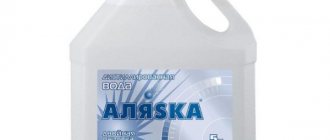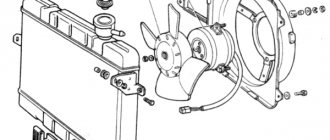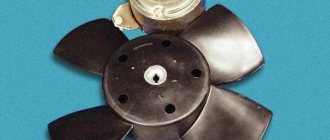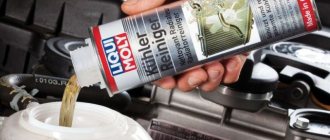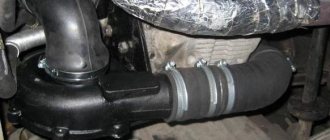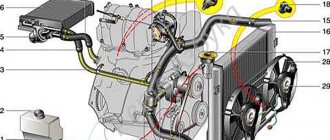Of course, all VAZ-2110 drivers are well aware that only 23% of the thermal energy that is released in our combustion chamber is beneficial. That is, less than a quarter of all heat is converted into kinetic energy. The rest of the heat simply warms the engine and escapes into the atmosphere. And, of course, everyone understands the faster this excess heat is removed from the engine, the more efficiently it will work. This is why our top ten have introduced a liquid cooling system.
Why flush the cooling system?
Antifreeze gradually accumulates deposits that impair the performance of the engine cooling system.
The cooling system of the VAZ-2110 works in hellish conditions . You can’t envy her, because in addition to antifreezes of dubious quality that litter the shelves (such as “antifreeze” in a beautiful blue color), the cooling system is badly affected by banal dust and dirt. There is plenty of this stuff on our roads. It is external contamination of the radiator, cylinder block, and heater radiator that often causes overheating.
And where there is overheating, there is the release of sediment and clots by antifreeze.
Danger
Cloudy liquid in the expansion tank indicates significant contamination of the engine cooling system.
All this settles not only on the wall of the water jacket, but also in the honeycombs of both radiators - the stove and the cooling radiator. After several years of such operation, the engine may overheat even in cold weather under light load. The thermal conductivity of radiators and cylinder block walls is rapidly falling, and the temperature gauge needle is stubbornly creeping up.
Consequences
To avoid consequences, at least occasionally inspect the condition of the cooling system visually. You can start by inspecting the coolant reservoir.
And this leads to very unpleasant consequences:
- overheating of the cylinder head causes it to warp, this cannot be cured and the head has to be replaced;
- the head gasket burns out with antifreeze getting into the oil and oil into the antifreeze;
- overheating of the piston-liner pair often leads to engine seizure;
- If antifreeze breaks through into the combustion chamber, it is quite possible to get a water hammer, and this is completely equivalent to replacing the engine.
This is why it is so important to keep your cooling system clean and in good working order.
When to flush
During operation, the radiator of the cooling system may become clogged. Moreover, it comes from the outside and from the inside. Today, manufacturers are trying to use higher quality materials, but even they do not protect against corrosion and scale.
If the antifreeze used is not replaced in time, it can also negatively affect the condition of the unit. A complex of such phenomena leads to the cooling system becoming dirty and in need of urgent cleaning.
It is not difficult to determine contamination of CO (cooling system) by a constantly overheating engine, regardless of weather conditions.
The frequency of flushing directly depends on operating conditions, engine condition, CO components used, etc.
How and with what to flush the cooling system on a VAZ-2110
Many people start flushing the system by draining the old antifreeze. In vain, because first of all it is necessary to keep the radiator and engine clean.
Mechanical cleaning of the radiator.
If the radiator honeycombs are clogged from the outside with dirt, leaves, flies and winter road fill, there can be no talk of any cooling. The same applies to the cylinder block and engine head. Some engines are difficult to see from under a layer of dirt and oil mixture that covers the entire engine. Naturally, the heat transfer of such engines suffers greatly.
That is why, first of all, it is worth thoroughly flushing the engine and radiator outside. It is advisable to use any detergents and water under reasonable pressure for this. It is better not to get too excited with pressure, since strong pressure can damage the radiator honeycombs. There are special means for externally flushing the radiator, but practice shows that they differ from dishwashing detergents only by being overpriced.
Will folk remedies help?
Folk remedies for flushing can be quite effective, but use them at your own peril and risk.
But to flush the system from the inside, folk remedies are not enough. No Coca-Cola or other nasty stuff is good for this.
All this can only make the situation worse. It is also unacceptable to flush the system with well water or tap water - this water is too hard, which implies a huge amount of salts and minerals. They will definitely settle on the walls of the water jacket and radiator honeycombs from the inside and will completely ruin the cooling system, although after draining plain water it may look perfectly clean, causing the illusion of a sterile system.
Chemistry comes to the rescue!
The inside of the system is washed only with special products, which are abundant in stores and are inexpensive compared to a new radiator. All these means are aimed at decomposing and removing organic fats and mineral scale, which is what clogs the system the most. In general terms, all flushes are divided into several types:
- Alkaline washings are inexpensive but ineffective means, although with a low degree of contamination they can bring a positive result.
- Two-component washes. When using them, you must strictly adhere to the instructions; they are poured in a certain sequence; after each cycle, the system is washed with distilled water. The result is very good.
The two-component set consists of an acid and an alkaline wash.
- Acidic foods . Aggressive washings are used mainly in cases of heavy contamination. Their disadvantage is that they can affect the materials of the cooling system.
- Neutral washes. Basically, they are preventative agents and you shouldn’t expect any special results from them in a heavily contaminated system.
“Soft” flushing is suitable if the antifreeze is changed regularly and there are no signs of contamination of the cooling system.
It is important to remember that different types of washes should never be mixed.
This can lead to the formation of new clots, and in the best case, the effect of the drugs will be mutually compensated and the result will be zero. The key rule when using rinsing is to strictly follow the instructions for the liquid and use it in combination only with good quality distilled water.
Types of cleaning
Cleaning the engine cooling system is divided into two types.
- External. In this case, the procedure includes removing accumulated dirt, dust, and insects from the surfaces of the unit. Use regular pressurized water and car shampoos.
- Internal. This is a more drastic measure in which internal contamination of the system is removed, scale, rust, and debris accumulated there are removed. The work takes a lot of time and effort, but without this you will not be able to eliminate the problem of engine overheating.
Very often the system becomes dirty for a trivial reason - beginners use plain water as a coolant. Due to the presence of a large number of impurities, deposits form almost immediately on the walls of the radiator, heat transfer deteriorates, and the car has to be repaired.
Article on the topic: Eliminating vibration of the gearshift lever on a VAZ 2114
How does the engine get clogged?
Many car owners are faced with the following situation: coolant that has just been poured into the engine gradually turns black. This is due to the fact that when filling, clean liquid passes through dirty radiator tubes, as a result of which it changes color and simultaneously clogs the remaining clean hoses and pipes of the engine. As a result, engine power drops to 10% and characteristic noise appears in the radiator.
At the same time, you need to understand that the radiator is contaminated not only by dust, but also by specific deposits. The composition and structure of these deposits depends on the coolant used by the driver. In 90% of cases the cooling system is flooded:
- Water. Moreover, some car enthusiasts still pour water directly into the radiator. During the summer months, this leads to the formation of scale on the pipes, which leads to clogging of the entire system. In winter, the water in the radiator turns into ice cubes, which renders the engine unusable.
- Antifreeze. Antifreeze effectively cools the engine (especially in winter), but after 1-2 months its gradual decomposition begins. Decomposition products enter the inside of the cooling system along with the liquid and clog the pipes.
Removing the radiator
- We drain the coolant from the heating system by unscrewing the plug on the drain hole and the cap on the expansion tank. Prepare a container in advance to collect the liquid that will be drained.
- To eliminate the possibility of a short circuit, be sure to remove the negative terminal on the battery.
- We remove the frill, and to do this you will need to unscrew the screw, which is located under the brake cylinder. In addition, the frill is screwed on with four screws and is also held in place by two clamps. In addition, it will be necessary to unscrew a couple of left screws and only after this will it be possible to dismantle the frill along with the wind cover.
- We find the coolant level sensor, remove the terminal and the hose through which air enters the cabin from the expansion tank.
- We remove the windshield wipers, which are attached to four screws, and also remove the hose from the windshield washer.
- Access to the stove radiator is blocked only by the fan housing, filter and other elements of the heating system. All we have to do is disconnect the existing hoses and we can start flushing the radiator.
Detailed replacement instructions
Next, we present the sequence of operations with a detailed photo report:
- We carry out the replacement on a well-warm-up engine.
- It is advisable to drive the car onto a lift or inspection ditch
- Open the filler cap
Remove the filler plug
- This will help prevent the formation of a vacuum in the engine housing and thereby ensure the most complete drainage of oil
- Take the key 17 and unscrew the plug from the oil pan
- We first substitute the container we prepared in advance
Take a 17mm wrench (or a 17mm socket with a wrench) and unscrew the plug from the pan
- Draining used oil from the engine
- We advise you to perform this operation carefully, the lubricant is hot and you can get burned.
- When unscrewing, it is better to use a long wrench with a handle (or a socket with a long wrench) and let the plug simply fall into the working container.
- Remove the cork after it has cooled down
- The duration of oil draining into the container is at least 10 minutes or until the stream of oil disappears from the pan
If you decide to flush the engine, now is the time, if not, just skip this point:
- Fish out and screw the plug back into the pan
- Fill flushing oil through the filler neck to the minimum mark on the dipstick - level meter
- Let the engine run for ten minutes, then drain the flush and proceed to replacing the filter
- Take the oil filter wrench and unscrew the filter
Unscrew the filter using a special wrench
- If you don't have such a key, use a strong screwdriver or awl
- We punch the filter housing in a direction perpendicular to the fitting located inside the filter (we punch it away from the motor so as not to touch this fitting) and unscrew it by rotating the handle of the screwdriver used
We pierce the filter with a screwdriver (away from the motor and perpendicular to the fitting) and unscrew it, using the screwdriver as a lever
- Let the oil drain completely from the fitting
- Wipe the filter seat and around it with a rag
- Before installing a new filter, fill it with fresh engine oil to approximately half capacity, and then lubricate the rubber O-ring of the new filter
- This will protect the lubrication system from air entering when starting the engine and protect its parts from operating without lubrication.
Pour fresh oil through a funnel into the new filter to about half the volume, lubricate the rubber O-ring
What's in it?
So, you purchased a car and don’t know what exactly is in the cooling system. If there is water or already used coolant there, this does not bode well for your engine.
Therefore, first of all, check whether there is any coolant in the engine at all, and what exactly it is. At the same time, make sure there are no leaks from the pipes or radiator.
It is not difficult to independently determine the type of fluid used by the old owner.
- Antifreeze almost always has a blue or blue color.
- Antifreeze is mainly available in red or green. Moreover, there are a huge variety of shades of red.
- It is not difficult to distinguish water from blue or green liquid.
- If the color of the coolant has a characteristic shade of rust, then this indicates the need for urgent replacement.
Green antifreeze
Mixing different coolants. Yes or no?
In some cases, the quality of the fluid is good enough that it is not necessary to replace it. Only the quantity is somewhat below the required level.
Let's say you have antifreeze filled, but you only have antifreeze on hand. What to do in such a situation? Many VAZ 2114 owners are interested in whether it is possible to mix different compounds.
Antifreeze or antifreeze
There is no consensus on this matter. Let us say for sure that a disaster will not occur from mixing, antifreeze and antifreeze will not react and will not explode the car. But we definitely cannot recommend combining two types of coolant in one tank. Follow the instructions in your car's manual, fill in what the factory recommends, and then you won't have any problems.
Antifreeze is simply a type of antifreeze developed in Soviet times for Zhiguli cars. This was done due to the low quality of the antifreeze offered at that time. Since then, antifreeze is the number one choice for VAZ.

